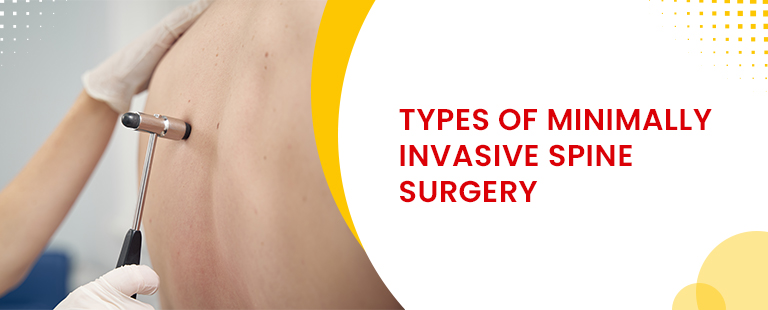Types Of Minimally Invasive Spine Surgery
Minimally invasive spinal surgeries use smaller incisions to ensure lesser damage to surrounding muscles and ligaments of the spine. Endoscopic spine surgery has the following advantages over traditional surgeries, such as:
- Endoscopic spine surgery has a faster recovery time.
- Lesser chance of infection and blood loss.
- Recovers faster and can return to a regular lifestyle
- The minimally invasive spine surgery success rate is high.
Here are a few different types of minimally invasive spine surgery:
- Discectomy
So, starting with Discectomy, what is minimally invasive spine surgery? It is a surgical process of removing material that presses on spinal cord nerves because of a herniated or bulging disc. It is performed to treat pinched nerves (nerve root compression), sciatica, bone spur, or radiating pain through limbs, known as radiculopathy.
In this surgical procedure, surgeons use a retractor, special microscope or endoscope to remove herniated discs. It helps to make smaller incisions that can be recovered quickly. This procedure takes less than an hour under general anaesthesia, and patients can return to their homes in a few hours.
- Anterior Cervical Discectomy and Fusion (ACDF)
What is minimally invasive spinal fusion surgery? It is an orthopaedic procedure in which a disc is removed through the front neck to relieve pressure and pain from the spine. To stabilise the neck, the surgery is combined with fusion surgery.
- Foraminotomy
It is surgical to widen the tunnels in the back where nerves leave the spinal canal. Foraminotomy, one of the types of minimally invasive spine surgery, can be used to treat various spine conditions such as:
- Foraminal Stenosis
- Pinched Nerve
- Herniated Disc
- Sciatica
- Bone
- Spur
- Radiculopathy
- Laminectomy
The lamina is the back of the vertebra that covers the spinal canal to protect it. The laminectomy is the surgical procedure performed to remove this lamina. It helps reduce the pressure from the spinal canal or spinal nerve in health conditions such as lumbar stenosis, herniated disc, and bone spur.
The laminectomy can be performed on any spine level using minimally invasive techniques. The minimally invasive laminectomy success rate is high. Patients who undergo single-level or two-level stenosis can return to their homes on the same day of surgery. It is performed to treat spinal stenosis, degenerative disc disease, and herniated disc. A more experienced doctor can ensure a higher minimally invasive laminectomy success rate.
- Spinal Instrumentation
This minimally invasive procedure keeps the segment immobile after the spinal fusion surgery. In this procedure, the surgeons insert screws and rods to align the spine bones while the bone graft heals.
Two minimally invasive spine surgery types instrumentation procedures are:
Percutaneous Pedicle Screws: In this procedure, surgeons use a minimally invasive technique to insert screws and rods. The doctor makes small incisions on both sides of the spinal column through which all the instrumentation is inserted using X-ray imagery. It helps to stabilise the spine without disrupting the healthy tissues. It is one of the preferred types of minimally invasive spine surgery.
Percutaneous Facet Screws: Facet joints are found in the spine; the facet screws are used to eliminate unwanted motion between these joints. They are used to position the targeted joints permanently in conjunction with bone grafting material at the time of joint structural and bone damage.
- Spinal Cord Stimulator Implantation
Spinal cord stimulator implantation is an orthopaedic surgical procedure that implants an impulse generator into the back. It sends an electrical current to the spinal cord to relieve chronic pain. The low voltage stimulation causes a tingling sensation to block pain. The procedure can treat failed back surgery syndrome and chronic pain. The success rate of this minimally invasive spine surgery is high.
- Corpectomy
Corpectomy is one of the most preferred types of minimally invasive spine surgery that involves the removal of the vertebra to remove pressure from the spinal cord and nerve. Corpectomy relieves pressure from stenosis, bone spurs, spinal fracture, tumour, or infection in the cervical, lumbar or thoracic spine.
The discs above and below the vertebrae and the middle portion of the bone are removed. Then, a bone graft or metal prosthesis is inserted to keep stable after the damaged structure has been removed.
For an excellent non invasive back surgery near you, visit Germanten Hospital. Our experts are highly regarded among the most experienced orthopaedic professionals, and we also have the latest facilities and advanced tech to ensure the different types of endoscopic spine surgery. So book your appointment now to understand more about the types of minimally invasive spine surgery and their success rates!


